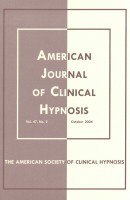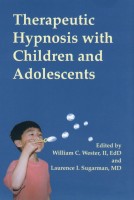


 |
||


|
||
|
About John Teleska's practice About John Teleska Contact Endorsements by colleagues About hypnotherapy Hypnosis for... fears, and phobias (including sexual abuse) Evidence-based medical uses of hypnosis Articles by John Teleska Client comments Client stories Selected bibliographies About Milton Erickson John Teleska's Music Site |

From Formal Hypnosis to Hypnotic Conversation Authors: John Teleska, M.Ed. Where: Abstract Hypnotherapeutic interactions can be mapped on a continuum from formal hypnosis to hypnotic conversation. Unlike the structured forms of formal hypnosis, hypnotic conversation relies upon utilizing the client’s responses, both verbal and non-verbal, to facilitate therapeutic process. In this paper, we illustrate this continuum with a series of anecdotal clinical examples starting with formal hypnosis and moving incrementally towards hypnotic conversation. Finally, we offer an example similar in appearance to formal hypnosis, but now described in the context of hypnotic conversation. We are neither putting forth a theory nor offering a new perspective for those who research hypnosis as a phenomenon. Rather, these ideas and metaphors serve to broaden the framework of what constitutes hypnotic interaction so as to evoke new opportunities for increasing therapeutic efficiency and efficacy. Click here to download a pdf file of this article. 
(a chapter in the book "Therapeutic Hypnosis with Children and Adolescents" edited by W. Wester, II, Ed.D and L. Sugarman, M.D.) Authors: John Teleska, M.Ed. Where: Quotes from reviewers "The joyful spirit of creative therapeutic hypnosis and psychotherapy with children and adolescents is well illustrated by the theory, practice, and research in this volume of practical approaches that can enrich the repertory of all professionals in their daily work." “A major undertaking, well conceived, and well executed. A source of wisdom from empathic clinicians who have created the best individual therapy for their patients.” “The editors and chapter authors constitute a distinguished array of authorities on the many aspects of hypnosis with children. They are to be commended for their most welcome and valuable contribution to the literature. This book with surely stand as a tour de force for years to come." Excerpts from part 1 of the chapter "Engaging Hypnotic Ability" (Although my practice consists primarily of work with adults, this chapter, written with clinicians in mind, applies to people of all ages. Here, the word "subconscious" is used in place of "unconscious." –JT) Overview In this chapter, we look at the phenomenology of hypnosis in an effort to tease out (1) what we mean by “hypnotic ability,” (2) how we learn to engage it in therapy, and (3) whether it can be measured in a clinically useful way. To do this, we first discuss hypnotic abilities by building on the notion of subconscious reflexes introduced in Chapter 1. This expansive but inclusive framework stretches beyond traditional notions of hypnotic phenomena and has important implications for working with children and adolescents. Next, we consider what helps us utilize these broadly defined capacities in therapy; that is, what are the postures and responses of the clinician that facilitate hypnotic engagement? Finally, we narrow our focus to the problem of attempting to gauge hypnotic ability in the midst of a dynamic process that we call hypnosis. Conscious abilities Sitting in his sixth grade classroom, Christopher listens intently to his teacher as she talks to the class about the ancient Egyptians. He decides to raise his hand and ask a question. Upon receiving the teacher’s response, he decides to nod his head “yes” to signal his satisfaction with the answer. He is consciously deciding to make those movements and aware that he has made them. In this case, raising his hand and nodding his head are conscious abilities. Subconscious abilities While giving his report about King Tut, in his excitement about the “Boy Pharaoh,” and without thinking about it, Christopher’s arms and hands move in support of what he says verbally. Someone raises his or her hand with a question. He looks at him or her to acknowledge the person, and without thinking about it, he raises his eyebrows and tilts his head towards him or her. He or she begins to talk, and, again without thinking about it, Christopher begins slowly nodding his head as he realizes it is a good question. He is not consciously managing his arm and hand movements, facial gestures, and head nodding, but they are not random movements. They are a coherent expression of his experience and responses. In this case, his body language is a subconscious ability. Everybody has differently structured subconscious abilities Christopher’s experiences illustrate the fact that everybody has subconscious abilities. In addition to body language, we intelligently and responsively accomplish digestion, respiration, walking, and hand-eye coordination all without conscious management. We are able to access memories relevant to what is being read, to experience interest or disinterest in parts of a conversation, construct mental images where relevant and inspect them, fill in gaps in a discourse, and plan a response—all of which are managed by what Lakoff and Johnson (1999) refer to as the “cognitive unconscious” (pp. 10-11). Depending on many variables—developmental stage, the social ecology in which one grew up, the nature of the significant relationships of one’s life, to name a few—these subconscious competencies are varied and differently coordinated within each of us. Hypnotic abilities Using the methods of hypnotic induction, a clinician suggests to me that, without any conscious effort on my part, one of my arms will lift off my lap the more I go into a trance. As my arm gradually levitates, I am not consciously aware of making it happen. My subconscious ability to move my arm has been engaged in the context of a hypnotic interaction. It is useful to consider any natural or acquired ability accessed and engaged in the context of hypnotic interaction as a hypnotic ability. So, in this case, the lifting of my arm is a hypnotic ability. Implications of this framing of hypnotic abilities The implications of this conceptualization of hypnotic ability are significant. There are no abilities that exist uniquely in the hypnotic domain. The hypnotic phenomena commonly described in the literature—arm levitation, ideodynamic signaling, analgesia, anesthesia, dissociation, amnesia—are based on natural or acquired subconscious abilities that have been accessed and engaged in the context of a hypnotic interaction. This framing of hypnotic abilities also suggests that there are many paths to a therapeutic goal. Because people have different structures of subconscious abilities, different clinician/patient dyads will entail different hypnotic interactions to generate similar hypnotherapeutic results. For example, …pain control is not always and only accomplished by utilizing the patient’s subconscious ability to selectively not notice certain sensations. Different people have different subconscious abilities and require different hypnotic approaches to accomplish pain control. Erickson and Rossi (1979) describe eleven hypnotic approaches to the engagement of the patients’ potential abilities to facilitate pain control, including direct suggestion, amnesia, hypnotic analgesia, hypnotic substitution of sensation, hypnotic displacement of pain, hypnotic reinterpretation of the pain experience, dissociation, and time distortion (pp. 97-192). The clinician’s proclivities—his or her expectations, past successes and failures, and what he or she is able to notice and engage within the patient—also shape the hypnotic interaction. Essentially, within this broad context, the hypnotic process is determined by the combined abilities of the patient/clinician dyad. Another implication of this framing is that most hypnotic talents do not have names. Hypnotic abilities – or phenomena – that have been given names in the literature typically satisfy the following conditions: (1) they are easy to describe (e.g., arm levitation, amnesia), (2) a significant portion of the population studied can access the requisite subconscious assets that form the basis for the named hypnotic ability, and (3) a significant number of clinicians and researchers have learned to use hypnotic interaction to generate the named hypnotic phenomenon. Each child possesses far more abilities and resources than we recognize…. As a result of the interplay of natural human development and our personal histories, each of us has our own types of abilities, conscious and subconscious. We have abilities that no one has thought to name. Milton Erickson’s genius was expressed in the creativity with which he accessed and engaged the unique capacities of each of his patients on behalf of promoting their health and well-being (Haley, 1986). The hypnotherapist need not think of his work as confined to engaging a standard set of hypnotic abilities—that some people are good at and some not. Rather, it is the hypnotherapist’s charge to study and to collaborate with each patient to create a hypnotic interaction that accesses and engages that patient’s unique and innate talents. Click here to see more articles by John Teleska |